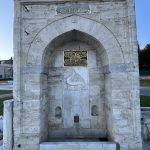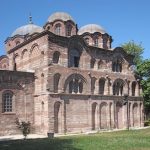“Wednesday”
Market: Wednesday (beside Fatih Cami)
For a taste of ultra-conservative İstanbul you need to head for the Çarşamba area of Fatih which lies between the Fatih and Yavuz Sultan Selim mosques. Here many women wear thick black cloaks reminiscent of chadors while many men wear fierce bushy beards and skullcaps. Come here on a Wednesday when the lively market from which the area may have taken its name (unless it was named after people from Çarşamba on the Black Sea who were resettled here in the 15th century) fills the streets.
While the most important historic monument here has to be the Yavuz Sultan Selim Cami, favourite of the Swiss-French architect Le Corbusier, there are a number of other minor monuments to look out for too, and you may enjoy seeing a side of the city that stands in stark contrast to the hip, happening image purveyed by most travel articles.
If you head downhill towards the Golden Horn from beside the Yavuz Sultan Selim Cami you should emerge eventually in Kücükmustafapaşa between Çibali and Fener.
Yavuz Sultan Selim Cami
Although it’s often thought of as a work of the great Ottoman architect Sinan, the plaque on the mosque actually says it was by a little known architect called Acem Ali. Inside, no columns were used to support the dome which gives it an unusual feeling of spaciousness. The mosque was completely restored on 2009. With its single dome and twin minarets it forms a distinctive and attractive feature of the İstanbul skyline.
Sultan Selim I (r. 1512-20) was buried in a tomb adorned with what are assumed to be İznik tiles in the grounds of the mosque which boasts a spectacular view over the Golden Horn. Later Sultan Abdülmecid (r. 1839-61) was also buried here, in a tomb designed by Garabet Balyan. 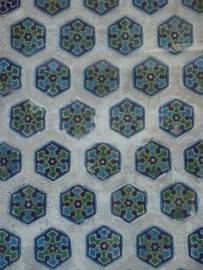 Tiles on tomb of Sultan Selim I
Tiles on tomb of Sultan Selim I
Just outside the mosque grounds is the Sultan Abdülmecid Evi, an elegant single-storey house commanding a superb view of the Golden Horn that was restored in 2012.
Right in front of the mosque is something of an oddity, a deep rectangular depression in the ground that you might think modern until you spot the crumbling Byzantine walls around the edge that identify it as the 5th-century Cistern of Aspar, otherwise known as Çukur Bostan (the Sunken Garden). As recently as the 1970s it still contained what John Freely described as “a very picturesque little farm village whose house-tops barely reach to the level of the surrounding streets” which was imaginatively recreated in Jenny White’s crime novel, The Abyssinian Proof.
Like the Cistern of Aetius in nearby Fatih, the hollow probably served as a giant reservoir to store water brought into the town centre from Thrace
Around Çarşamba
The big Wednesday market takes place in and around Darüş Safaka Caddesi that runs north from the Fatih Cami. If you don’t see much else of the suburb you might enjoy seeing what the locals buy here.
Off this street you will also see the big Darüşşafaka Lisesi (High School) that dates back to 1873. It was the successor to a school for the children of the tradesmen in the Grand Bazaar that was originally housed in the Simkeşhane in Beyazıt.
On the Fatih Cami side of the Cistern of Aspar the Sultan Sarnıçı, in Ali Naki Sokak, is a 4th-century underground cistern of the Yerebatan Sarnıçı type. It serves as a restaurant catering mainly to tour groups but it’s worth popping your head round the door to see the fine vista of 28 columns topped with Corinthian capitals, some of them also carved with crosses.
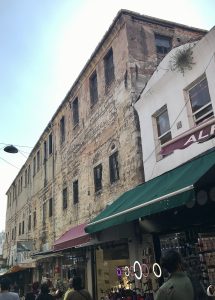
On the far side of the cistern the conservative early 18th-century İsmail Ağa Cami may not be the city’s most welcoming mosque although you may want to take a quick look. The main entrance is through an arch above which sits the original sibyan mektep (primary school) – you may not immediately spot the entrance as it is set into a line of shops that is supposed to make it look somehow like the Qa’aba in Mecca. At the back of the courtyard the old medrese is being reused for Koran classes. The many women you see wearing black chadors and the men with the bushy beards are usually adherents of the sect associated with this mosque which has had a politically charged modern history.
Just where Çarşamba rubs up against Fatih Cami there’s a neighbourhood curiously called Malta. Syrian refugees have a strong presence here and there are many small shops and lokantas selling the produce of Aleppo and Damascus. Here, too, is the brooding Şekerci Hanı, probably built in the 15th but expanded in the 17th. Today its gates are locked but in the past it provided lodgings for such luminaries as the theologian Said Nursi (1878-1960), the novelist Ahmet Hamdi Tanpınar (1901-62) and the poet Mehmet Akif Ersoy (1873-1936).
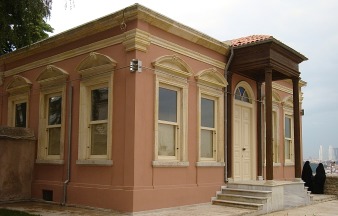 Restored Abdülmecid Evi, 1913Transport info
Restored Abdülmecid Evi, 1913Transport info
You can get to Çarşamba directly by bus from Eminönü or by walking from Fevzi Paşa Caddesi in Fatih.
Nearby areas

